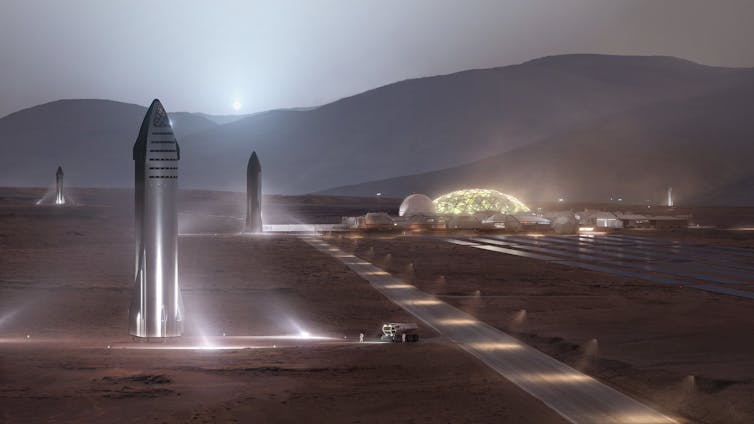
Could humans expand out beyond their homeworld and establish settlements on the planet Mars? The idea of settling the red planet has been around for decades. However, it has been seen by sceptics as a delusion at best and mere bluster at worst.
Mars might seem superficially similar to Earth in a number of ways. But its atmosphere is thin and humans would need to live within pressurised habitats on the surface.
Yet in an era where space tourism has become possible, the red planet has emerged as a dreamland for rich eccentrics and techno utopians. As is often the case with science communication, there’s a gulf between how close we are to this ultimate goal and where the general public understands it to be.
However, I believe there is a rationale for settling Mars and that this objective is not as far off as some would believe. There are actually a few good reasons to be optimistic about humanity’s future on the red planet.
First, Mars is reachable. During an optimal alignment between Earth and Mars as the two planets orbit the Sun, its possible to travel there in a spacecraft in six to eight months. Some very interesting new engine designs suggest that it could be done in two months. But based on technology that’s ready to go, it would take astronauts six months to travel to Mars and six months back to Earth.
Astronauts have already stayed for this long on the International Space Station (ISS) and on the Soviet orbiting lab Mir. We can get there safely and we have already shown that we can reliably land robots on the surface. There’s no technical reason why we couldn’t do the same with humans.
Second, Mars is abundant in the raw materials required for humans to “live off the land”, in other words, achieve a level of self sufficiency. The red planet has plentiful carbon, nitrogen, hydrogen and oxygen which can be separated and isolated, using processes developed on Earth. Mars is interesting and useful in a multitude of ways that the moon isn’t. And we have technology on Earth to enable us to stay and settle Mars by making use of its materials.
A third reason for Mars optimism is the radical new technology that we can put to use on a crewed mission to the planet. For example, Moxie (Mars Oxygen In-Situ Resource Utilization Experiment) is an project developed by scientists at the California Institute of Technology (Caltech) that sucks in Martian atmosphere and separates it into oxygen. Byproducts of the process – carbon monoxide, nitrogen and argon – can be vented.
When scaled up, similar machines would be able to separate oxygen from hydrogen to produce breathable air, rocket fuel and water. This makes it easier to travel to the planet and live on the surface because it’s not necessary to bring these commodities from Earth – they can be made once on Mars. Generating fuel on the surface would also make any future habitat less reliant on electric or solar-powered vehicles.
But how would we build the habitats for our Mars settlers? Space architect Melodie Yasher has developed ingenious plans for using robots to 3D print the habitats, landing pads and everything needed for human life on Mars. Using robots means that these could all be manufactured on Mars before humans landed. 3D printed homes have already been demonstrated on Earth.
Volunteers have also spent time living in simulated Mars habitats here on Earth. These are known as Mars analogues. The emergency medicine doctor Beth Healey spent a year overwintering in Antarctica (which offers many parallels with living on another planet) for the European Space Agency (Esa) and communicates her experience regularly.
She is not alone, as each year sees new projects in caves, deserts and other extreme environments, where long term studies can explore the physical and psychological demands on humans living in such isolated environments.
Finally, the Mars Direct plan devised by Dr Robert Zubrin has existed for more than 30 years, and has been modified to account for modern technology as the private sector has grown. The original plan was based on using a Saturn V rocket (used for the Apollo missions in the 1960s and 1970s) to launch people. However, this can now be accomplished using the SpaceX Falcon 9 rocket and a SpaceX Dragon capsule to carry crew members.

Several uncrewed launches from Earth could ferry necessary equipment to Mars. These could include a vehicle for crew members to return on. This means that everything could be ready for the first crew once they arrived.
For astronauts making the journey to Mars, radiation is the biggest problem. But using certain materials in the walls of the spacecraft or building a protective shelter inside the vehicle could shield astronauts from high energy particles. Similar ideas could apply to 3D printed habitats on the Martian surface. Alternatively, settlers could live underground or in Martian caves.
On Mars, there’s a 24-minute communication delay with Earth. This means that Martians will need to be self-sustaining and less reliant on their homeworld from the beginning. While this could pose challenges, they are not insurmountable.
Elon Musk’s Starship vehicle, which launches on the most powerful rocket ever built, could be a game changer. Starship is currently undergoing testing at SpaceX’s facility in southern Texas. It is hard to overstate what a reliable Starship, that has been cleared to carry humans, could do for exploration of the moon and Mars.
Lower costs, higher payloads and larger crews all make for a far more efficient programme of lunar and Martian exploration. Yet even without it, everything we need to travel to Mars is currently available or in exciting late stages of development. There will not be a shortage of well-suited astronauts eager to go.
![]()
Sam McKee does not work for, consult, own shares in or receive funding from any company or organisation that would benefit from this article, and has disclosed no relevant affiliations beyond their academic appointment.



